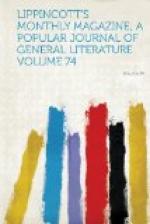LITERATURE OF THE DAY.
Gareth and Lynette. By Alfred Tennyson, D.C.L., Poet-Laureate. Boston: J.R. Osgood & Co.
“With this poem the author concludes the Idyls of the King.” The occasion is a tempting one to review the long series of Arthurian lays written by Tennyson, from the Mort d’ Arthur, and the pretty song about Lancelot and Guinevere, and the first casting of “Elaine’s” legend in the form of The Lady of Shallot, down to the present tale, flung like a capricious field flower into a wreath complete enough without it. The poet’s first adventure into the subject—the mysterious, shadowy and elevated performance called the Mort d’ Arthur—will probably be always thought the best. Tennyson, when he wrote it, was just trying the peculiarities of his style: he was testing the quality of his cadences, the ring of his long sententious lines repeated continually as refrains, and the trustworthiness of his artful, much-sacrificing simplicity. He put as it were a spot or two of pigment on the end of his painting-knife, and held it up into the air of the vaporous traditions of the Round Table. It stood the test, it had the color; but the artist, uncertain of his style, his public and his own liking, made a number of other tentatives before he could decide to go on in the manner he commenced with. He tried the Guinevere, laughing and galloping in its ballad-movement; he tried the Shallot, with a triple rhyme and a short positive refrain, like a bell rung in an incantation, and brought up every minute by a finger pressed upon the edge. Either of these three—although the metre of the first was the only one endurable by the ear in the case of a long series of poems—either of these had, it may be positively said, a general tone more suitable to the ancient feeling, and more consistent with the duty of a modern poet arranging for new ears the legends collected by Sir Thomas Malory, than the general tone of the present Idyls. Those first experiments, charged like a full sponge with the essence and volume of primitive legend, went to their purpose without retrospection or vacillation: each short tale, whether it laughed or moaned, promulgated itself like an oracle. The teller seemed to have been listening to the voice of Fate, and whether, Guinevere swayed the bridle-rein, or Elaine’s web flew out and floated wide, or Lancelot sang tirra-lirra by the river, it was asserted with the positiveness of a Hebrew chronicle, which we do not question because it is history. But we hardly have such an illusion in reading the late Idyls. We seem to be in the presence of a constructor who arranges things, of a moralist turning ancient stories with a latent purpose of decorum, of an official Englishman looking about for old confirmations of modern sociology, of a salaried laureate inventing a prototype of Prince Albert. The singleness of a story-teller who has convinced




